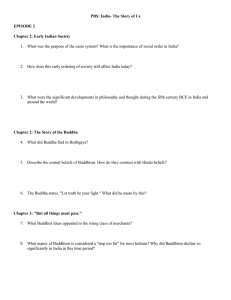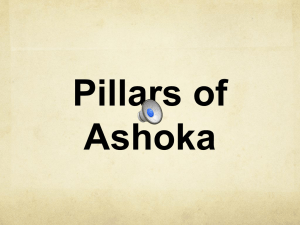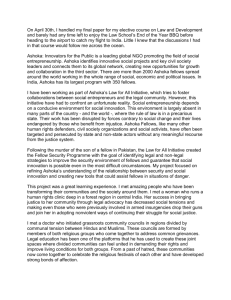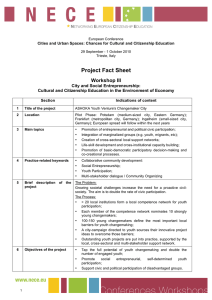Jennifer Kieser - Missouri Western State University
advertisement
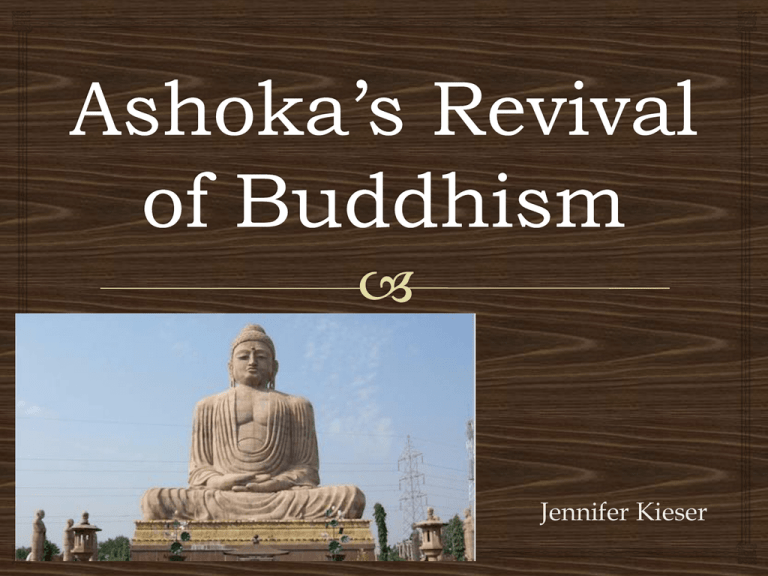
Jennifer Kieser Overview - Ashoka’s Early Life The Beginning of Ashoka’s Reign Geography – maps of Ashoka’s empire The Kalinga War Buddhism & A New Ashoka Ashoka’s Goal: The Spread of Buddhism Highlights Early Life of Ashoka o From a young age, Ashoka showed great fighting qualities o Ashoka became a fierce warrior and a heartless general - Story: Ashoka rose to power by getting rid of the legitimate heir to the throne by “tricking him into a hole filled with hot coals” o Some other stories tell of how Ashoka supposedly “killed 99 of his brothers, sparing only one” in order to get the throne for himself (http://en.wikipedia.org/wiki/Ashoka#Early_life) Ashoka’s Reign 268 BCE – Ashoka Maurya becomes emperor of India (Keown 70) Reign of Ashoka according to Keown was ~ 268-239 BCE 270 BCE – Ashoka becomes emperor (Tilakaratne 16) Reign of Ashoka according to Tilakaratne was ~ 270-230 BCE The Mauryan Empire ~ 269 BCE (at the beginning of Ashoka’s reign) Image From: ( http://en.wikipedia.org/wiki/File:Chandragupta_Maurya_Empire.gif ) "Wicked King" Ashoka was very wicked and had an extremely bad temper He tested the loyalty of his ministers (had 500 killed) When a few women in his harem insulted him, he had all of them burnt to death Ashoka also, according to some sources, kept a torture chamber (earned him the name “Ashoka the Fierce”) From: http://en.wikipedia.org/wiki/Ashoka#Early_life_as_Emperor Thus, the Kalinga War. . . Odisha The Kalinga War was fought ~ 262-261 BCE In Modern-day India’s Odisha (Odissa) Image Attribution: CC-by-sa PlaneMad/Wikimedia ( http://en.wikipedia.org/wiki/File:India_Orissa_locator_ma p.svg ) Kalinga Ashoka’s life-changing campaign The bloodiest battle that Ashoka had ever participated in Battle resulted in huge numbers of both civilian and soldier casualties (http://www.buddhanet.net/e-learning/dharmadata/fdd9.htm) “It is said that in the aftermath of the Battle of Kalinga the Daya River running next to the battle field turned red with the blood of the slain; more than 150,000 Kalinga warriors and about 100,000 of Ashoka's own warriors were among those slain.” (http://en.wikipedia.org/wiki/Kalinga_War) Ashoka’s Empire ~ 265 BCE (or ~ 250 BCE) After the Kalinga War in the East Attribution: Vastu at en.wikipedia Buddhism & Ashoka • After Kalinga, Ashoka sees all the destruction caused by the war • He reflects on his ‘victory’ and feels remorse for all the lives lost • Ashoka converts to Buddhism • Uses the Buddha’s teachings and principles to rule his empire with a new attitude, a different way of thinking • Given new names, such as: Ashoka the Great, Samraat Chakravartin (emperor of emperors), Priyadarshin (He who regards everyone with affection) (factsninfo.com) The New Ashoka Now seen as the “ideal king” A model for Buddhist followers • New motto – ahimsa (“non-violence” toward all things) = No more violent sports, no more hunting, etc. Spreads the teachings to his family members & to his people Builds stupas to promote Buddhism Then he expands this idea – he wants to spread Buddhist teachings even further Spread of Buddhism: The Missions of Ashoka • Image From: http://en.wikipedia.org/wiki/File:Asoka_Kaart.gif Spread of Buddhism: The Missions of Ashoka Ashoka’s Goal: spread the principles and teachings of Buddhism to countries outside India Missionaries – even his own son and daughter – were sent out to accomplish his goal and build monuments to the Buddha King Ashoka sent missionaries to: Sri Lanka (by Arhat Mahinda, son of Ashoka) Myanmar (by bhikkhunis named Sona and Uttara) Thailand Cambodia (Tilakaratne pp. 80, 83, 86, 89, respectively) Highlights Ashoka was born about 304 BCE (factsninfo.com) King Ashoka conquered through bloody battles Last campaign – The Kalinga War – changed his outlook on life Ashoka then chose to rule according to Buddhist principles and: Spread Buddhism teachings outside of India through missionaries Saved Buddhism from dying out (as it was at the time of his reign) His surviving stupas (shrines to the Buddha) resurrected Buddhism again in the 20th Century Ashoka died about 232 BCE at the age of 72 (factsninfo.com) Bibliography Keown, Damien. Buddhism: A Very Short Introduction. Oxford University Press, 2000. • Tilakartne, Asanga. Theravada Buddhism: The View of the Elders. University of Hawai’i, 2012. • Heehs, Peter. Indian Religions: A Historical Reader of Spiritual Expression and Experience. NYU, 2002. • http://www.budsas.org/ebud/ebdha023.htm • http://www.buddhanet.net/e-learning/dharmadata/fdd9.htm • http://online.sfsu.edu/rone/Buddhism/footsteps.htm • http://www.factsninfo.com/2013/04/interesting-facts-information-samratashoka-great-emperors-of-india.html • http://www.rk-world.org/dharmaworld/dw_2011jmfounder.aspx • http://www.religionfacts.com/buddhism/history/asoka.htm Images: • • • • • • • http://en.wikipedia.org/wiki/Kalinga_War http://en.wikipedia.org/wiki/Odisha http://en.wikipedia.org/wiki/File:India_Orissa_locator_map.svg http://en.wikipedia.org/wiki/Maurya_Empire#Ashoka_the_Great http://en.wikipedia.org/wiki/File:Asoka_Kaart.gif http://en.wikipedia.org/wiki/Edicts_of_Ashoka

